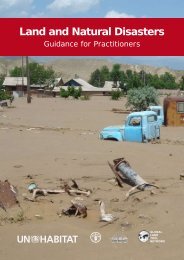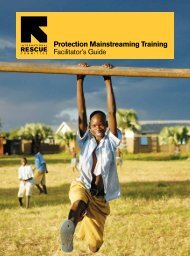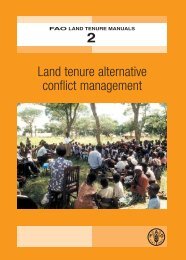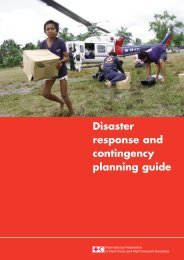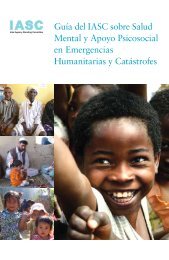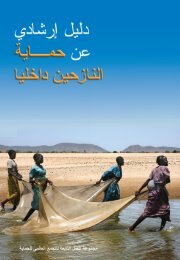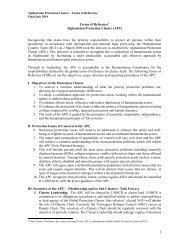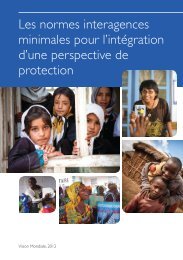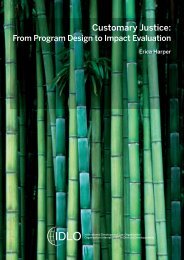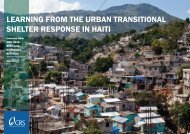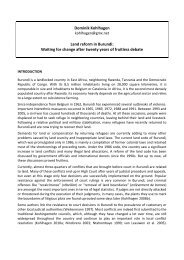Inter-Agency Real Time Evaluation of the Response to Cyclone Nargis
Inter-Agency Real Time Evaluation of the Response to Cyclone Nargis
Inter-Agency Real Time Evaluation of the Response to Cyclone Nargis
Create successful ePaper yourself
Turn your PDF publications into a flip-book with our unique Google optimized e-Paper software.
a. Length and nature <strong>of</strong> experience <strong>of</strong> <strong>the</strong> interviewee in Myanmar, along with a description <strong>of</strong><strong>the</strong>ir own role in <strong>the</strong> humanitarian response <strong>to</strong> cyclone <strong>Nargis</strong>.b. Identification <strong>of</strong> <strong>the</strong> key events or miles<strong>to</strong>nes relevant <strong>to</strong> <strong>the</strong> humanitarian response and abrief explanation <strong>of</strong> how <strong>the</strong>y came about and what impact <strong>the</strong>y had.c. Things that should have been done differently.d. Description and examples <strong>of</strong> beneficiary accountability systems that are in use or beingplanned by <strong>the</strong> agency.e. Coordination mechanisms <strong>the</strong>y have been involved with, an assessment (including a ranking)<strong>of</strong> <strong>the</strong>ir usefulness and causal fac<strong>to</strong>rs, recommendations for improvement.f. How <strong>the</strong> interviewee felt how this IA RTE could be most useful in moving forward.g. Any important questions not asked.3. Observation: Members <strong>of</strong> <strong>the</strong> team participated in nine cluster meetings and spent 8 daystraveling through different parts <strong>of</strong> Bogalay Township where <strong>the</strong>y had an opportunity <strong>to</strong> observe <strong>the</strong>extent <strong>of</strong> <strong>the</strong> impact <strong>of</strong> <strong>the</strong> cyclone and <strong>the</strong> state <strong>of</strong> recovery <strong>of</strong> affected communities.4. Focus Group Discussions: A <strong>to</strong>tal <strong>of</strong> 17 focus group discussions were held in 10 villages inBogalay Township (see itinerary map in annex). The majority <strong>of</strong> <strong>the</strong>se focus groups were separatedaccording <strong>to</strong> gender, except in two communities where FGD were held with separategroups/committees that had been set up at different times by UNDP and CARE <strong>to</strong> participate inmicr<strong>of</strong>inance and distribution activities respectively. The team also held discussions with villageauthorities and religious leaders. Given <strong>the</strong> time constraints, <strong>the</strong> team had <strong>the</strong> option for <strong>the</strong> fieldvisits <strong>of</strong> ei<strong>the</strong>r making relatively short visits <strong>to</strong> each <strong>of</strong> <strong>the</strong> affected <strong>to</strong>wnships, or spending over aweek visiting one <strong>to</strong>wnship. Acting on <strong>the</strong> advice <strong>of</strong> <strong>the</strong> in-country Advisory Group for <strong>the</strong> IA RTE,<strong>the</strong> team opted <strong>to</strong> spend eight days in one <strong>of</strong> <strong>the</strong> <strong>to</strong>wnships (Bogalay) <strong>to</strong> better understand howcommunities in less- and more-affected areas had been impacted by <strong>the</strong> cyclone and <strong>the</strong> status <strong>of</strong><strong>the</strong>ir recovery. Following <strong>the</strong> field visit, two validation workshops <strong>of</strong> initial findings were held inYangon with NGOs, one for international NGOs in English and a second one for national NGOs inMyanmar language. These workshops, along with additional KII with agency staff and documentresearch helped in understanding <strong>the</strong> similarities and differences between Bogalay and o<strong>the</strong>r affected<strong>to</strong>wnships in <strong>the</strong> Delta.Usually in such time-limited activities, unless prepara<strong>to</strong>ry discussions have taken place withcommunities (preferably someone with whom <strong>the</strong>re is a pre-existing trust relationship) evaluationteams <strong>of</strong>ten need <strong>to</strong> spend considerable time explaining <strong>the</strong> difference between a needs assessment(easily <strong>the</strong> most frequent reason for a visit by foreigners) and an evaluation – along with <strong>the</strong>disheartening news that <strong>the</strong> evaluation team has nothing <strong>to</strong> <strong>of</strong>fer in terms <strong>of</strong> assistance. In <strong>the</strong>Myanmar context, however, <strong>the</strong> IA RTE’s team’s work was aided considerably by <strong>the</strong> open andconstructive nature <strong>of</strong> <strong>the</strong> discussions with communities.During all 17 FGD with communities, without exception, it was enough <strong>to</strong> explain <strong>the</strong> objectives andapproach <strong>of</strong> <strong>the</strong> IA RTE and clarify that <strong>the</strong> team could <strong>of</strong>fer nothing in <strong>the</strong> way <strong>of</strong> assistance.Moreover, even though this seemed <strong>to</strong> be <strong>the</strong> first time that communities visited by <strong>the</strong> IA RTE teamhad been split in<strong>to</strong> male and female focus groups, but <strong>the</strong>y willingly divided in<strong>to</strong> groups with <strong>the</strong>desired outcome, with both men and women entering directly in<strong>to</strong> frank and informativeconversations.Due <strong>to</strong> time constraints, <strong>the</strong> IA RTE team was presented with <strong>the</strong> option <strong>of</strong> spending short periods ineach <strong>of</strong> <strong>the</strong> affected <strong>to</strong>wnships, or allocating time <strong>to</strong> look more in-depth within a single <strong>to</strong>wnship.33



